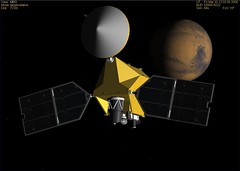
The Mars Reconnaissance Orbiter (MRO) spacecraft is in its final approach to Mars today, and late this afternoon (4:24 pm Eastern time), it will perform an orbital insertion burn to enter an initial high-ecentricity orbit. Over the next 6-7 months, a series of some 500 aerobraking maneuvers will use drag from Mars' thin atmosphere to circularize the orbit to its operational state. You can learn more about MRO and its arrival and follow the JPL mission timeline here.
Thanks to Orbiter add-on developer Brian Jones and Orbiter Forum member "Peter3210," you can simulate the arrival of MRO yourself. Brian's MRO add-on is available at avsim.com (search for mro.zip), and Peter has posted a set of instructions and a starting scenario for simulating the mission from 7 am EST to the insertion burn.
I heard a pretty good report about MRO on NPR this morning (a rare and wondrous thing to hear a space story on the radio, though more likely on NPR than anywhere else). MRO has some amazing instruments on board, and if all goes well, it could return 10 times as much information about Mars over the next few years than all past Mars missions combined.
P.S. at 5:46 pm EST - I parked NASA TV on my tool bar for the last 90 minutes so I could half-watch the JPL control room as the spacecraft's signal was lost and reacquired, both right on time. Early telemetry shows that MRO is in its initial Mars orbit and is healthy. Very cool!
1 comment:
Looks like we tuned in about the same time. I also pulled up the NASA TV webcast right about the time of LOS. At first I thought that I had missed it, but then I realized that all of the times I had been seeing were for PST.
The one thing that struck me most was how many people it took to manage this mission. There were at least a couple of dozen engineers manning the various stations. It's only been recently that I've began to come to the understanding that the majority of the cost of any space mission, manned or unmanned, is probably paying the salaries of all of the people required to build and support the spacecraft and its mission. This is probably obvious to some, but it never really hit me until recently. Watching the room full of engineers monitoring the MRO just drove this point home for me even more so.
Post a Comment